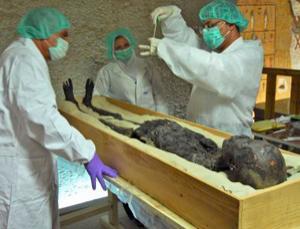Royal rumpus over King Tutankhamun's ancestry
Can we be sure which mummy was the daddy? When a state-of-the-art DNA analysis of Tutankhamun and other ancient Egyptian royals was published last year, its authors hailed it as "the final word" on the pharaoh's family tree. But others are now voicing doubts.
The analysis of 11 royal mummies dating from around 1300 BC was carried out by an Egyptian team led by Egypt's chief archaeologist Zahi Hawass. The project was overseen by two foreign consultants, Albert Zink of the EURAC Institute for Mummies and the Iceman in Bolzano, Italy, and Carsten Pusch of the University of Tübingen, Germany.
The researchers used the DNA data to construct a family tree of Tutankhamun and his immediate relatives. The study, published last February in the Journal of the American Medical Association (vol 303, p 638), concluded that Tutankhamun's father was the pharaoh Akhenaten, that his parents were brother and sister, and that two mummified foetuses found in Tutankhamun's tomb were probably his stillborn daughters – conclusions that have since become received wisdom.
But many geneticists complain that the team used inappropriate analysis techniques. Far from being definitive, the study is "not seen as rigorous or convincing", says Eline Lorenzen of the Center for GeoGenetics at the Natural History Museum in Copenhagen, Denmark. "Many of us in the DNA community are surprised that this has been published."
Degraded DNA
Ian Barnes, a molecular palaeobiologist at Royal Holloway, University of London, is also concerned. "In my experience it is not very easy to get these results," he says. "I can't do it, and I've spent a long time trying."
Zink and his colleagues used a genetic fingerprinting approach that involves testing variable regions of the genome called microsatellites, which are made up of short sequence repeats. The numbers of repeats vary between individuals, and by comparing the number of repeats across several microsatellites it is possible to work out whether or not individuals are related.
However, researchers rarely attempt this approach with ancient samples because the original DNA is likely to be degraded, and dwarfed by modern contamination. It's more common to sequence mitochondrial DNA (mtDNA) – cells contain around a thousand times more copies of mtDNA than of genomic DNA, improving chances of finding large intact samples.
Zink and Pusch defend their choice, saying that they took extensive precautions to guard against contamination. For instance, they extracted samples from deep inside the mummies' bones, and genotyped lab staff to rule out contamination.
Not deep enough
But others doubt the precautions were sufficiently rigorous. Robert Connolly of the University of Liverpool, UK, who carried out blood typing of Tutankhamun's mummy in the 1960s, argues that it would be difficult to reach deep enough inside Tutankhamun's thin, fragile bones – or those of the two fetuses – to reach uncontaminated material.
Lorenzen adds that many people – not just the Hawass team – have handled the mummies since they were first unwrapped. The authors should have tested non-human samples from the tombs as negative controls, she says.
To judge the quality of the team's results, Lorenzen and others are asking for access to raw data not included in the Journal of the American Medical Association paper – but Zink is reluctant to oblige, fearing the data would spark "a lot of arguing" over technicalities.
However, Zink, Pusch and colleagues insist that they will soon be able to put any doubts to rest. They say they have also extracted the mtDNA that Lorenzen and others consider necessary for rigorous genetic analysis and are still working on the data. They hope to publish the results this year.
But the critics are still advising caution. "When working with samples that are so well-known, it is important to convince readers that you have the right data," says Lorenzen. "I am not convinced."
Source: New Scientist, 21/01/11
- Συνδεθείτε για να υποβάλετε σχόλια
 Εκτυπώσιμη μορφή
Εκτυπώσιμη μορφή- Send by email

